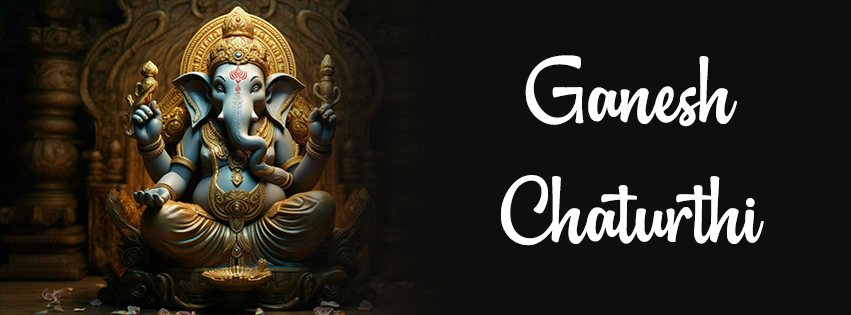Sadguru Shatanand Swami names Lord Swaminarayan as below within the Sarvamangala Namavali
સર્વમંગલ નામાવલી – મંત્ર ૮૨૯
ૐ લડ્ડુકાદીષ્ટગણપાય નમઃ
ભાદરવા શુદ ૪ ના દિવસે ગોળના લાડું, દુર્વા, વગેરે પૂજન સામગ્રીથી ગણપતિની પૂજા કરનારા
Sarvamangala Namavali Mantra No. 829
Aum Laḍḍukādīṣhṭagaṇapāya namah
Bhādaravā shud 4 nā divase goḷanā lāḍun, durvā, vagere pūjan sāmagrīthī gaṇapatinī pūjā karanārā
I bow to the Lord who performed worship of Ganapati with Ladoo (made with jaggery), Durva (Cynodon Dactylon) etc on the fourth day of the bright half month of Bhadrapad/Bhadarvo – (Sud 4)
Lord Swaminarayan instructs His followers in the 84th verse of the Shikshapatri to offer obeisance to Vishnu, Shiva, Ganapati, Parvati and the Sun. Shatanand Swami honoured Him in the 77th mantra of the Janamangal Namavali (Aum Panchayatan-Sanmanaay Namah) which highlights the Shikshapatri verse.
In the 127th verse of the Shikshapatri, Lord Swaminarayan instructs the Acharyas (Spiritual heads of the Nar Narayan Dev and Laxmi Narayan Dev diocese) to perform worship of Ganapati on the fourth day of the bright half of the month of Bhadrapada and that of Hanuman on the fourteenth day of the dark half of the month of Ashwin.
As per the Ganapati-Khanda of the Bhramavaivarta Purana, Ganapati/Ganesh has been established as first worshippable deity amongst the Gods.
Sadguru Shatanand Swami elaborates on the 127th verse of Shikshapatri in the Shikshapatri Arth Deepika (Bhashya)
The fourth day of the bright half of Bhadrapada is famous as Siddhi Vinayak Chaturthi. On this day, the worship and prayer shall be offered to Ganapati – the destroyer God of troubles. An earthen idol of Ganapati shall be installed and worshipped with Sindur, sacred grass, and sweet – balls.
This worship and Poojan does not attract the fault of worshipping other God. Bhavishyottar Puran prescribes this day for worship and veneration of Ganapati : ‘An earthen or Gold-idol of Ganapati shall be worshipped by wise people on the fourth day of the bright half of Bhadrapada month. The idol shall be given a bath of oil of white sesame seeds in the morning and in noon time, within personal capacity. Ganapatiji shall be worshipped with sacred grass and sweet-balls.
One who worships in such manner, becomes free from all the pains and never faces any hardship. He then attains desired fruits.’ Now says about determining such fourth day. Fourth day with the sight of the third day is better. If there are two days of the fourth in the fortnight, then such first fourth day shall be considered for veneration of Ganapatiji – or should be taken such fourth day which has Abhijit lunar mansion. If such fourth day belongs to next day, in such cases noon time shall be a preferred time. These are the observations from Vratotsava Vidhi.
In the 4th Prakran of Shreemad Satsangi Jeevan Lord Swaminarayan further elaborates on how to celebrate this day.
“O sons! Lord Krishna took birth as Ganapati, son of Shiva, on Sunday, Bhadarvo Sud Choth, when the moon was in Hasta Nakshatra and the Sun was in Virgo constellation.
Just as the Devtas celebrated Ganapati’s birth with joy, we should celebrate his birth anniversary similarly in our temples. Choth in Vedh with Trutiya should be given priority to decide the day of festival of Ganapati Choth. If there are two Choth on two consecutive days (whether both prevalent at midday or not), the first Choth in Vedh with Trutiya should be considered to celebrate the festival. However, if the first Choth (even if it is in Vedh with Trutiya) is not prevalent at midday and the second Choth is prevalent at noon, the festival should be celebrated on the second Choth.
The Pujari should prepare a Murti of Ganapati from clay depicting a head of an elephant with a long trunk and one tusk with four arms. The Pujari should worship Ganapati at midday with vermillion, blades of holy grass Durva, leaves of Shami (prosopis spicigera) and Bili (eagle marmaloss), flowers of Karan and Shirish and Tulsi (basil) leaves. Tulsi can be used in worship of Ganapati ONLY on this day.
Nobody should look at the moon on the night of Ganapati Choth. One has to face the prospect of false allegation against them if they look at the moon inadvertently.
To guard against such an eventuality, one should read or listen to the Katha from the Tenth canto of the Shreemad Bhagwat where Bhagwan Krishna was alleged to have stolen a diamond called ‘Syamantak’. If neither is possible (read or listen to), one should sincerely chant the hymn meaning ‘A lion killed King Prasen, Jambuvan (abear) killed the lion. O Sukumarak! Do not cry and despair. Smayantak diamond is yours only.’ One is protected by the curse of looking at the moon on this night by chanting this hymn ten times.”

